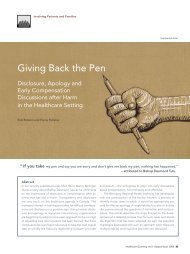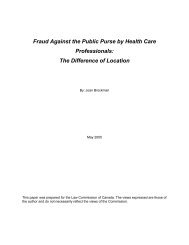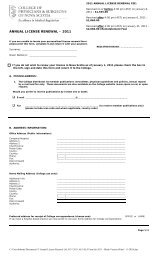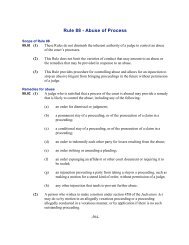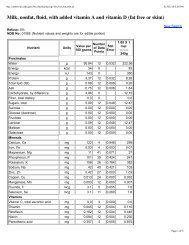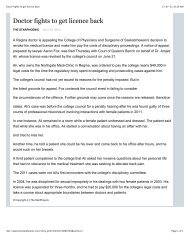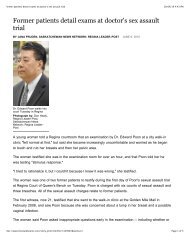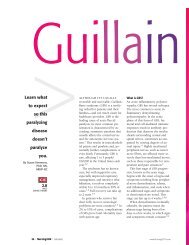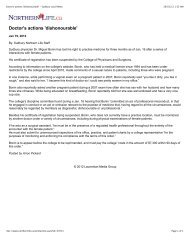Experiments That Changed Nutritional Thinking - TUUM EST
Experiments That Changed Nutritional Thinking - TUUM EST
Experiments That Changed Nutritional Thinking - TUUM EST
You also want an ePaper? Increase the reach of your titles
YUMPU automatically turns print PDFs into web optimized ePapers that Google loves.
1052S<br />
SUPPLEMENT<br />
Steenbock, H. & Black, A. (1924) J. Biol. Chem. 61: 405–422. In August 1969, John Rotruck, perusing the Biochemistry<br />
Suda, T., DeLuca, H. F., Schnoes, H. K., Ponchon, G., Tanaka, Y. & Holick, M. F.<br />
(1970a) Biochemistry 9: 2917–2922.<br />
Journal, came across a paper by R. E. Pinto and W. Bartley<br />
Suda, T., DeLuca, H. F., Schnoes, H. K., Tanaka, Y. & Holick, M. F. (1970b) (1969). The paper was on the effect of age and sex on glutathi-<br />
Biochemistry 9: 4776–4780.<br />
one peroxidase and glutathione reductase activities in rat liver<br />
Windaus, A., Schenck, F. & von Werder, F. (1936) Hoppe-Seyler’s Z. Physiol.<br />
homogenates. This paper presented a pathway of glutathione<br />
Chem. 241: 100–103.<br />
metabolism that connected glutathione with the enzyme glutathione<br />
peroxidase. The reduced form of glutathione converts<br />
Paper 20: Glutathione Peroxidase: hydrogen peroxide to water most efficiently when it is catalyzed<br />
A Role for Selenium (Rotruck 1972) by the enzyme glutathione peroxidase. A figure in this paper<br />
illustrated the proposed relationship of glutathione, glutathi-<br />
Presented by Richard A. Ahrens, Department of Nutrition and one reductase, glutathione peroxidase and NADPH. It was<br />
Food Science, College of Agriculture and Natural Resources, Uni- also noted that glucose metabolism is the main source of<br />
versity of Maryland, College Park, MD 20742 as part of the NADPH. With this figure in front of him, John began to<br />
minisymposium ‘‘<strong>Experiments</strong> <strong>That</strong> <strong>Changed</strong> <strong>Nutritional</strong> Think- develop that same afternoon a hypothesis that selenium played<br />
ing’’ given at Experimental Biology 95, April 11, 1995, in Atlanta, a role in glutathione peroxidase. He generated a one-page<br />
GA.<br />
research proposal that was presented to Hoekstra, complete<br />
The first practical biologic interest in selenium occurred in with misspelled words and typographical errors, that same afthe<br />
1930s, when selenium was associated with alkali disease. ternoon. Hoekstra said that, as far as he knew, this was the<br />
This disease was called more graphically the ‘‘blind staggers’’ first research proposal of an involvement of selenium with<br />
in certain northern range areas and resulted from selenium glutathione peroxidase, and he reacted with enthusiasm. John,<br />
poisoning from forage grown on those shale soils. The standard however, had another year of heavy course work ahead of him<br />
treatment for such poisoning was to provide very small before he began to fully implement his proposal in the summer<br />
amounts of certain arsenic compounds in the feed or water of of 1970. Over the next several months the actual experimenta-<br />
livestock.<br />
tion progressed rapidly, culminating in studies demonstrating<br />
However, K. Schwarz and C. M. Foltz (1957) reported that incorporation of 75 Se into glutathione peroxidase. This portion<br />
traces of selenium prevented liver necrosis in certain vitamin of John’s Ph.D. dissertation took about 12 months to complete.<br />
E–deficient rats. Because vitamin E was known to be an antithis<br />
research reported on a glucose-dependent protection by<br />
The first publication (Rotruck et al. 1971) to come from<br />
oxidant nutrient, a role for selenium in repairing or preventing<br />
oxidative damage was soon being sought. The first paper de- dietary selenium against hemolysis of rat erythrocytes in vitro.<br />
scribing the enzyme glutathione peroxidase was also published <strong>That</strong> was also the year that John Rotruck left the University<br />
in the same year by G. C. Mills (1957). Glutathione peroxidase of Wisconsin and joined Procter and Gamble, where he had<br />
was reported to be an erythrocyte enzyme that protects hemothat<br />
research was first reported at the 1972 FASEB meetings<br />
a long career from which he retired in 1995. An abstract from<br />
globin from oxidative breakdown. Nobody in 1957 linked<br />
these two discoveries!<br />
(Rotruck et al. 1972a), and a subsequent publication on the<br />
In 1968 John T. Rotruck was assigned to the research laboselenium<br />
appeared later that year in the Journal of Nutrition<br />
prevention of oxidative damage to rat erythrocytes by dietary<br />
ratory of Professor W. G. Hoekstra to complete his Ph.D. studies<br />
at the University of Wisconsin. As these things often hapactually<br />
used the methodology from the original paper by Mills<br />
(Rotruck et al. 1972b). For this portion of the research, John<br />
pen, John Rotruck was initially assigned to work with another<br />
faculty member who promptly went off on a sabbatical leave. (1957) on glutathione peroxidase to establish that glutathione<br />
Hoekstra worked largely with the metabolic effects of zinc. He peroxidase was virtually nonexistent in selenium-deficient rats.<br />
was no particular expert in selenium or glutathione peroxidase, These papers from Madison did generate some controversy,<br />
but he was familiar with the whole field of trace mineral rephotometric<br />
method to study bovine erythrocyte glutathione<br />
because L. Flohe’ (1971), working in Germany, used a spectro-<br />
search. Although attempts to understand selenium’s mode of<br />
action had focused on its potential role as an antioxidant, peroxidase and reported that it contained ‘‘no non-protein<br />
these theories had not been uniformly accepted. Indeed, John prosthetic group.’’ He responded negatively to the 1972 reports<br />
Rotruck recalls that some faculty members at the University by Rotruck, but he did decide to recheck his earlier concluof<br />
Wisconsin did not believe that selenium could be part of sions. In the next year, the last part of John Rotruck’s disserta-<br />
an enzyme. In 1968 and 1969, he was engaged largely in taking tion research was published in Science and demonstrated the<br />
classes prior to the heavy research engagement that was to uptake of 75 Se by glutathione peroxidase and the fact that<br />
characterize his last two years in the Ph.D. program in bio- selenium was tightly bound to the enzyme (Rotruck et al.<br />
chemistry.<br />
1973). The controversy ended when Flohe’ et al. (1973) pub-<br />
Being an enthusiastic graduate student, John Rotruck read lished a letter reporting that glutathione peroxidase was, inthe<br />
literature on glutathione biochemistry because of the simiworkers<br />
deed, a selenoenzyme. The 1973 paper by Rotruck and colarities<br />
between selenium and sulfur chemistry and biochemisviews<br />
was identified as a Nutrition Classic in Nutrition Re-<br />
try. Glutathione is the common name of g-glutamylcysteinylin<br />
in 1980 and as a ‘‘Citation Classic’’ in Current Contents<br />
glycine. It is therefore a tripeptide composed of glutamic acid,<br />
1988. A RDA for selenium was established in 1989, and in<br />
cysteine and glycine. The sufhydryl group of cysteine is reactive 1992 John Rotruck and Bill Hoekstra received the Klaus<br />
and tends to form disulfide bonds with other glutathione mole- Schwarz Commemorative Medal for this work.<br />
cules when oxidized. Glutathione functions as a reducing agent John Rotruck recalls that it was the research environment<br />
to maintain other molecules in the reduced form and can at his time in the Biochemistry Department at the University<br />
convert hydrogen peroxide in the body to water. When it is of Wisconsin that made such discoveries possible. Just across<br />
oxidized to its double form linked by disulfide bonds, it can the hall from him, Hector DeLuca’s students were explaining<br />
be reduced to the sulfhydryl form. The enzyme that does that how vitamin D worked. Down the hall from them was John<br />
is called glutathione reductase, and it uses NADPH as a source Suttie’s laboratory where the role of vitamin K was being<br />
of hydrogen to achieve this reduction.<br />
explained. Nobel Prize winners came to speak on their research<br />
/ 4p09$$0062 04-07-97 14:02:12 nutras LP: J Nut May Suppl<br />
Downloaded from jn.nutrition.org by on June 3, 2010



